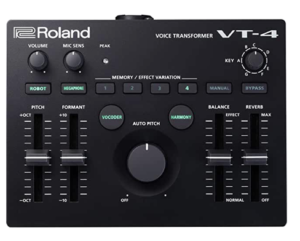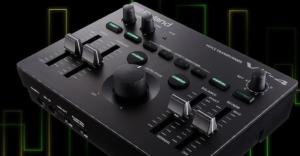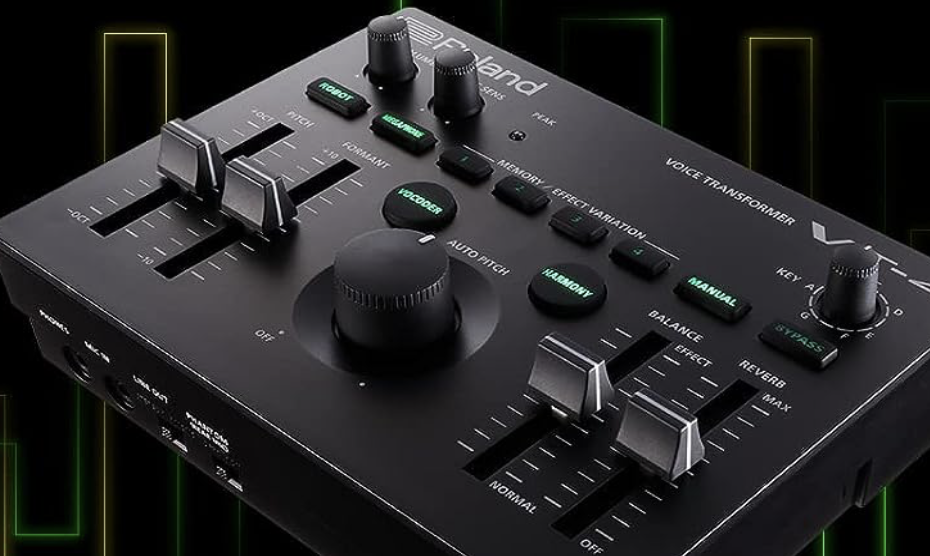The Roland VT-4 Vocal Transformer is a compact and versatile voice effects processor designed specifically for vocalists and electronic musicians. It allows you to manipulate and shape your vocal sound in creative and innovative ways. Here are some key features and aspects of the Roland VT-4:
 Pitch and Formant Shifting
Pitch and Formant Shifting
One of the standout features of the Roland VT-4 [buy here] is its ability to shift the pitch and formants of your voice independently. This allows you to create robotic, gender-bending, or otherworldly vocal effects.
Pitch and Formant Shifting are advanced vocal processing techniques available in the Roland VT-4 Vocal Transformer. These features allow you to manipulate your vocal sound in unique and creative ways, altering both the pitch and timbre (formants) of your voice independently. Here’s a more in-depth explanation of Pitch and Formant Shifting:
- Pitch Shifting:
- Pitch shifting involves changing the fundamental frequency of the vocal signal, effectively raising or lowering the pitch of your voice. This can be used to create harmonies, simulate multiple voices, or produce otherworldly vocal effects.
- In the VT-4, you can apply pitch shifting to your vocals in real-time. You might be able to shift the pitch up or down by a certain number of semitones or cents (a smaller unit of pitch measurement).
- For example, if you sing a note and apply pitch shifting of +5 semitones, the VT-4 will generate a harmony that is five semitones higher than your original note.
- Formant Shifting:
- Formants are the resonant frequencies of the vocal tract that give each voice its distinct timbre or color. Formant shifting allows you to adjust these resonances without changing the pitch of the voice.
- By shifting the formants, you can make your voice sound deeper, higher, more masculine, more feminine, or even create non-human vocal textures.
- Formant shifting can dramatically change the character of your voice while maintaining the same pitch.
- Combining Pitch and Formant Shifting:
- The VT-4 typically allows you to apply both pitch and formant shifting simultaneously. This means you can create effects like a high-pitched robotic voice with a deep, resonant timbre.
- Expression and Creativity:
- Pitch and formant shifting offer a wide range of creative possibilities. You can use them to create harmonies, produce vocal textures that sound like different instruments or characters, and add an element of surprise to your vocal performances.
- These features are particularly popular in electronic and experimental music genres where unconventional vocal sounds are sought after.
- Real-Time Control:
- The VT-4’s intuitive interface allows you to control pitch and formant shifting in real-time using dedicated knobs or sliders. This makes it easy to manipulate your voice on the fly during performances.
- MIDI Control and Automation:
- Some versions of the VT-4 might offer MIDI control, allowing you to automate pitch and formant shifts using external MIDI controllers or DAW automation.
Pitch and Formant Shifting in the VT-4 open up a world of creative vocal possibilities, allowing you to transform your voice into something entirely different.
Check Low Price Now on Amazon!
Also Read:
Zoom V3 Vocal Processor Review
Boss VE-500 Vocal Performer Review
9 Best Vocal Effects Pedals for 2023
How to isolate vocals from a song
Fender Starcaster: Reviving a Classic
 Vocal Effects and Processing
Vocal Effects and Processing
The Roland VT-4 [buy here] provides a wide range of vocal effects and processing tools to transform your voice. These effects include pitch shifting, formant shifting, harmonizing, vocoding, reverb, delay, and more.
The VT-4 includes harmonizing capabilities, allowing you to generate harmonies that follow your lead vocals. It also offers auto-pitch correction to help you sing in tune.
Vocoder
The vocoder feature in the Roland VT-4 [buy here] adds a unique and futuristic element to your vocal performances. By blending your voice with synthesized tones, you can create captivating and memorable vocal effects that enhance your musical expression.
 Vocoder effects enable you to blend your voice with synthesized tones, creating robotic or synthetic vocal textures. The VT-4 allows you to use external audio sources as the carrier signal for the vocoder.
Vocoder effects enable you to blend your voice with synthesized tones, creating robotic or synthetic vocal textures. The VT-4 allows you to use external audio sources as the carrier signal for the vocoder.
The vocoder is a fascinating and distinctive vocal effect that’s often associated with electronic and synthesized music. In the context of the Roland VT-4 Vocal Transformer, the vocoder feature allows you to blend your voice with synthesized tones, creating robotic or otherworldly vocal textures. Here’s a more detailed explanation of the vocoder feature in the VT-4:
A vocoder works by analyzing the spectral content of your voice and applying it to a carrier signal, which can be an external sound source like a synthesizer or an internal synthesizer engine.
The carrier signal’s characteristics influence the tonal qualities of your voice, resulting in a fusion of human vocals and synthesized sound.
Synthesized Tones
 In the Roland VT-4 [buy here], you can use the vocoder to combine your voice with a variety of synthesized tones, allowing you to create unique vocal textures that sound robotic, otherworldly, or like an instrument.
In the Roland VT-4 [buy here], you can use the vocoder to combine your voice with a variety of synthesized tones, allowing you to create unique vocal textures that sound robotic, otherworldly, or like an instrument.
The synthesized tones can be simple or complex, ranging from harmonically rich sounds to more abstract and experimental tones.
External Audio Source: The VT-4 may allow you to use an external audio source as the carrier signal for the vocoder. This means you can use a synthesizer or any audio input to shape the final vocoder sound.
With the VT-4’s intuitive controls, you can adjust the balance between your natural voice and the synthesized carrier signal. This lets you control how much of the vocoder effect is applied to your vocals.
Creative Applications
Vocoder effects are commonly used in electronic, pop, and experimental music to create distinctive vocal textures. They can add an element of futuristic or robotic sound to your vocals, making them stand out in a mix.
Real-Time Control: The VT-4’s interface allows you to control the vocoder effect in real-time. This is particularly useful for live performances where you can modulate the vocoder sound dynamically.
 Some Optional Features
Some Optional Features
- MIDI Integration (Optional):
- Some versions of the VT-4 may offer MIDI connectivity, enabling you to control the vocoder effect using external MIDI controllers or devices.
- Expression Pedal Control (Optional):
- Depending on the model, the VT-4 might allow you to use an expression pedal to control certain parameters of the vocoder effect in real-time.
Other Features
- Real-Time Control: The VT-4 features a simple and intuitive interface with dedicated knobs and sliders for real-time control over various parameters. This makes it easy to make adjustments on the fly during performances.
- Memory Slots and Presets: The VT-4 allows you to save your custom settings as presets, making it convenient to recall your favorite vocal effects setups.
- Effects Chain: You can chain multiple effects together to create complex vocal textures. This allows you to experiment with different combinations of effects.
- USB Connectivity: The VT-4 can connect to a computer via USB, enabling integration with DAWs (Digital Audio Workstations) for recording and processing vocals.
- Compact and Portable: The VT-4’s compact size and USB bus-powered design make it easy to use both in the studio and for live performances.
- MIDI Integration: The VT-4 may support MIDI connectivity, allowing you to control various parameters and effects using external MIDI controllers.
- Expression Pedal Input: Some versions of the VT-4 might include an expression pedal input for real-time control over specific parameters.
The Roland VT-4 is designed for artists looking to explore and push the boundaries of vocal processing. Its unique features and creative potential make it a popular choice among electronic musicians,
